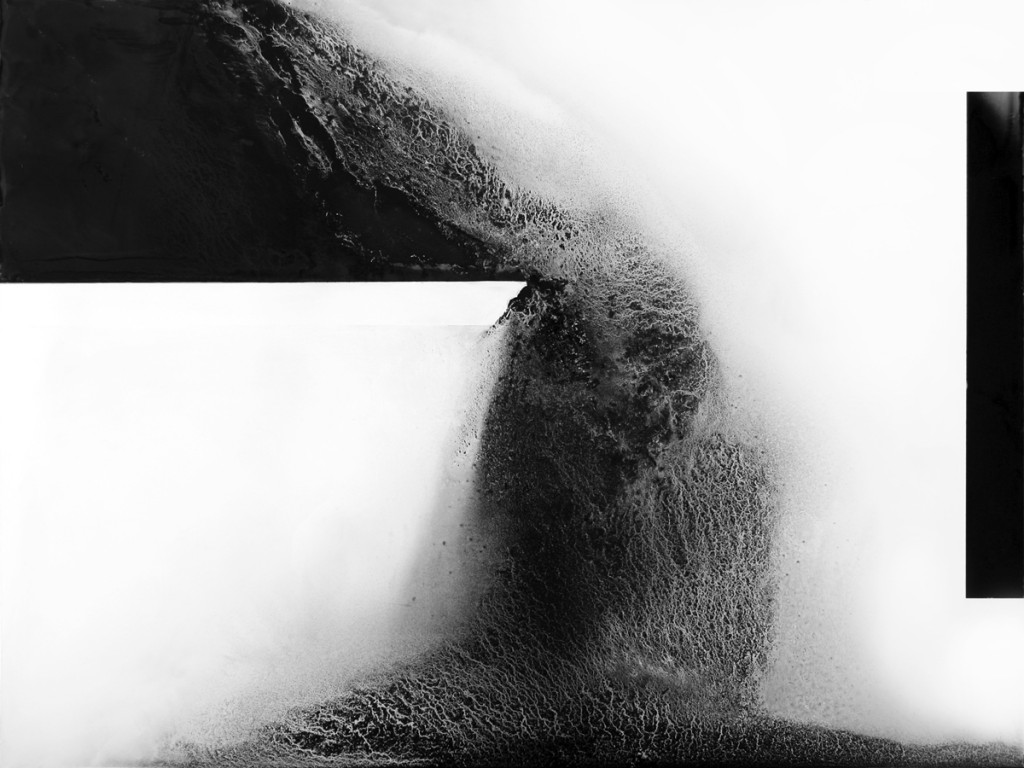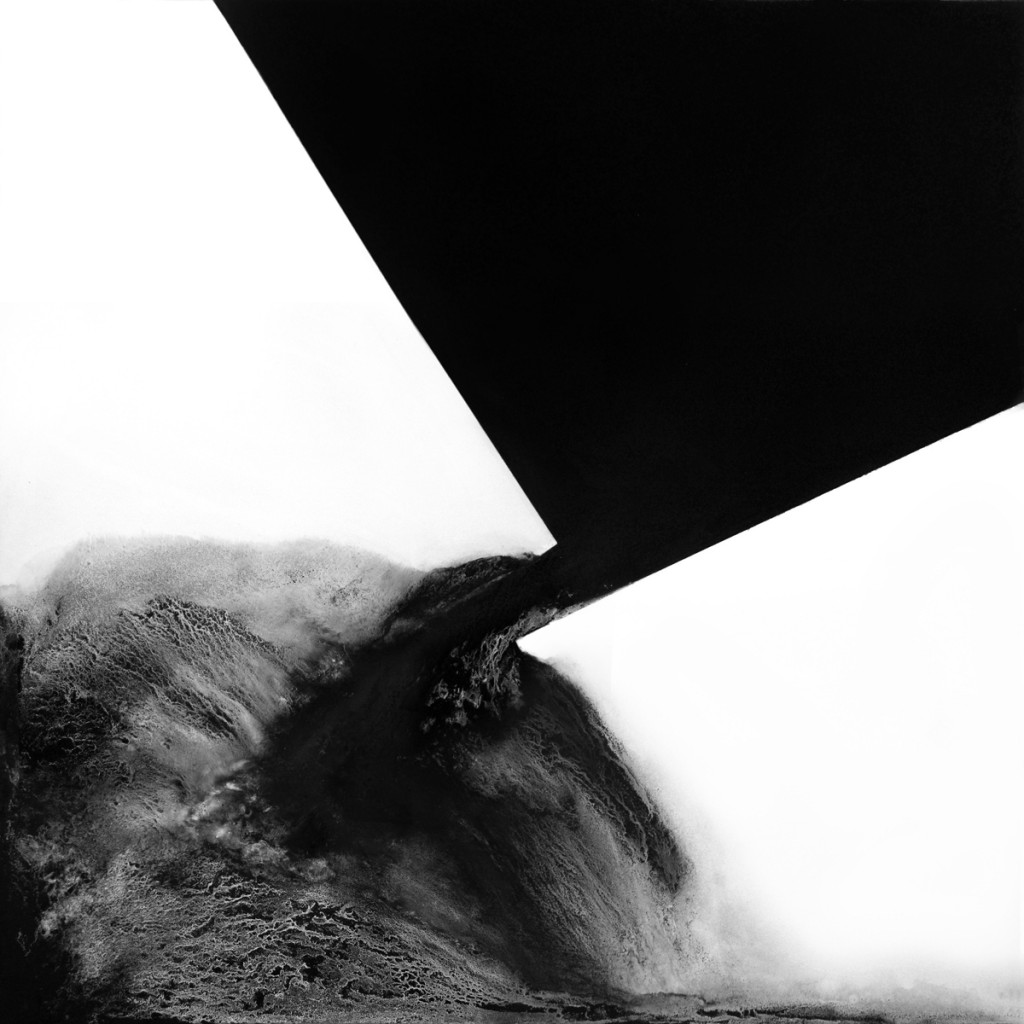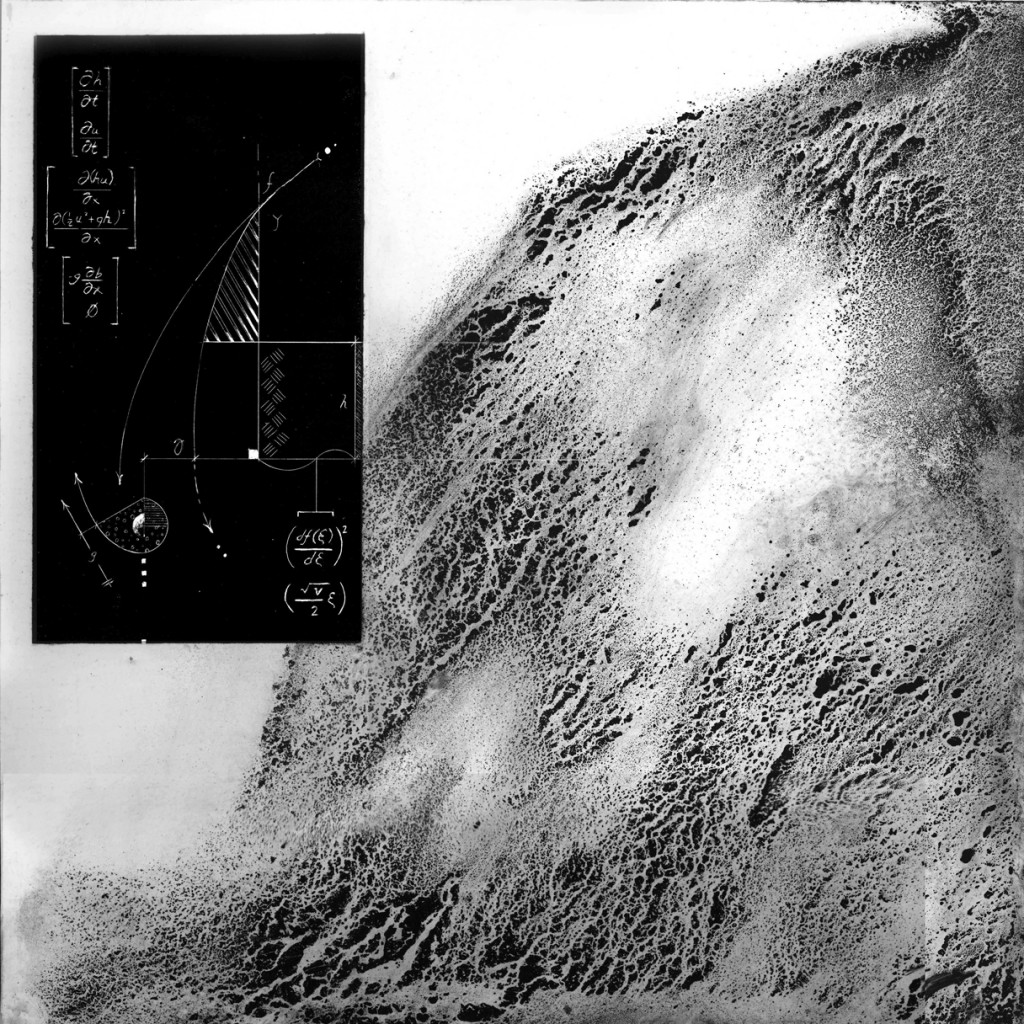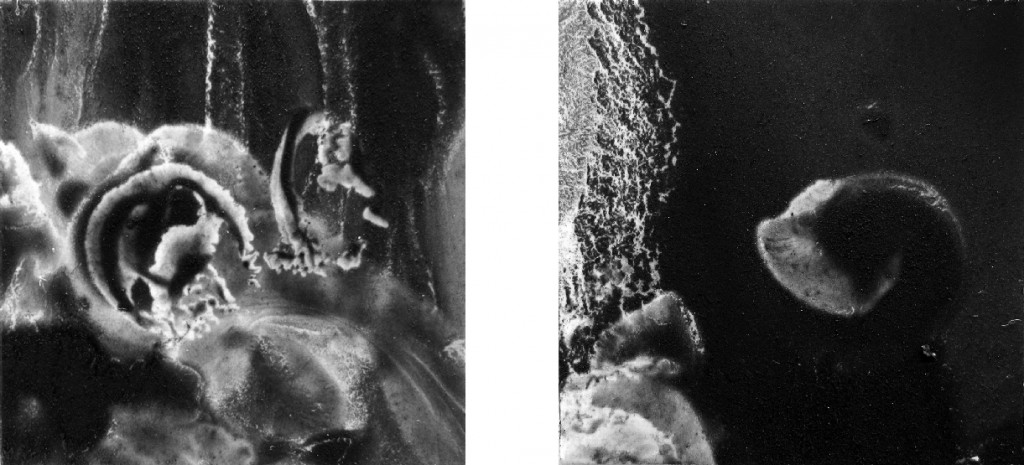Casey Lynch
All works by and courtesy of the artist.

TippingPoint, 2011, graphite on Dibond, 36″ x 48″
There is really only one way to describe the imagery of Seana Reilly’s “pourings”: undeniable. In a series of experiments with liquid graphite on Dibond, Reilly leads the viewer to more questions than answers, positing myriad dualities that coexist harmoniously to produce art that calls for serious contemplation, perhaps even meditation. Her awareness of materials and the moments in which they interact result in images of sublime beauty and delicate balance, and confronts us with the impasse between actual experience and our attempts to control our experience. Ultimately, Reilly’s work begs the question: If our passive awareness generates reality, then does an active awareness destroy it?

ResolvingKasimir, 2011, graphite on Dibond, 48″ x 48″
Casey Lynch: From your biography on The Atlanta Contemporary Art Center’s website, I understand that you practice Vipassana meditation. How does this practice influence you?
Seana Reilly: Vipassana meditation is part of the Theravadan tradition – the oldest form of Buddhism, still practiced in Southeast Asia and Sri Lanka. I learned it at the feet of Thai monks in a Wat temple just outside of Washington DC. It is a practice that centers around non-judgment. What this teaches is neither to condemn nor praise any particular thought, mood, urge, mental habit, etc. As these thoughts and emotions present themselves during meditation, you accept them as passing flights of fancy without judging them, then you let them go. It teaches you not to let your thoughts or moods jerk you around. Ultimately you are searching for the part of you that abides, that part does not get battered about with the waves of emotions, desires, and fortunes. Buddhism basically says that you are the creator of your own misery – your wants and desires and cravings make you unhappy, and they are insatiable. If you can see them for the ephemeral things they are, they no longer have control over you. You are not at the mercy of that first knee jerk reaction. You can chose how you react. You can be the eye of your own storm. Joy, regret, love, and anger will still be a part of your life, but you will no longer run toward or away from them. You can experience them without having your world pulled out from under you; experience them, but fully realize that they will pass. The only thing that never changes is that things change.
CL: I think that those ideas are apparent in your work. Formally, many of the pieces function between the duality of geometric and organic, and from what I can tell conceptually, between human control and “letting go.” Can you talk about the process of making these pictures?
SR: When I am pouring these paintings, I am earnestly trying to suspend judgment. I am searching for sheer joy in the existence of another physical entity without attaching any sort of value judgment to it; I do not desire it to be other than it is. I’m obviously approaching the precise mixture of binding agents and solvents from a very scientific place, but the execution of the work is more a release of expectation; I am defining boundaries, setting up parameters, and then stepping back to watch and (hopefully) be delighted – on a good day. Some days it completely runs off the edge of the panel. Then I start over.
I do still wrestle with how much I participate in what’s happening. Are my resists and dams set in place for me to participate or regulate? What criteria am I using to decide that it needs to be tilted more here and less there? By participating I am by default altering it – if I am going to let this just be what it is, why don’t I pour it on the panel & walk away for good? What is driving my decisions to make interventions? Perhaps it is a form of communion with this other – in an attempt to forget its other-ness. Or is it ego based? Do I need to assert some sort of ownership over it? I have no answers yet to any of these.

OmoriWake, 2011, graphite on Dibond, 12″ x 12″
CL: A tension is definitely at play in your work. In many pieces, such as OmoriWake, text that looks like scientific formula is integrated. I would say these pieces act less like sublime abstractions and more like a play on scientific inquiry that lends itself to a semiotic discussion, i.e, how do we cull meaning from a mysterious world (the imagery made by the graphite), and an even more mysterious explanation of it (the impenetrable formulae.)
SR: In that particular piece, the graphite happened to develop into a wave form. Because Japan had just been hit by a tsunami, it lead me to research scientific and mathematical symbols that dealt with seismology and liquids in motion, which I then rearranged into an oversized chop (Japanese signature block). It was subsequently titled after the Japanese scientist who developed a way to predict aftershocks.
My initial inspirations come from the physical world. (For context: I almost became a geologist). But the inspiration is not necessarily from the physical sciences themselves – these are conceptual notation systems that have been overlaid onto the earth. I find my inspiration in how the physical moves, accumulates, and erodes. And then I find my curiosity piqued by the systems we have chosen to overlay on those processes, and how we potentially limit our understanding of that singular unique thing by categorizing or defining it.

GenetiveCase, 2011, graphite on Dibond, 12″ x 12″
Sometimes I feel that we have over-intellectualized the physical world so much that we now hover two inches above the ground. We are disconnected from the actual. This may be one factor in the disassociation and apathy I see all around me. That paired with an overwhelming influx of raw data without structure or framework; but I digress… There has to a balance between the experiential and the intellectual – the fact and the symbol for the fact. Knowing through the physical is a different kind of understanding of a thing. I guess I’m saying that lab work is great, but do the field study.
CL: It seems understandable that there are dualities, and that in one way or another these dualities assimilate into a workable medium that is life. This is a quotidian understanding of yin and yang, an idea whose metaphor fits into much Eastern philosophy. I feel like I see a lot of Western artists and thinkers attempting to assimilate Eastern thought with Western philosophy; the problem of such contemporary thinking comes with the monkey wrench that is Western philosophy. Socrates tells us that the unexamined life is not worth living, and modern Western history delivers us the hegemony of Science. While Eastern and Western philosophies are not necessarily at odds, the implementation of science as a predictive, thus active awareness, separates it from the more accepting, passive consciousness of described by many Eastern philosophies, such as Vipassana. I think we must constantly remind ourselves that self-aware observation alters our perception of any such dualities. I see an attempt to examine this in your work, can you speak to my assertion?

ConveyanceLoss, 2012, graphite on drafting film, 64″ x22″
SR: For all of my adult years I have wrestled with a belief in both western science and Buddhist philosophy, and an inability to completely inhabit both. Each advocates for a somewhat different way of participating in the world (although they do have a good deal in common in methodology). Western science seems to me to be not so different in its worldview, but different in its application. Where Buddhists seek to observe and learn, western science aggressively controls to learn. And then you get into the whole quantum level of observation changing the thing being observed.

EpistemicDarkness, 2012, graphite on Dibond, 48″ x 30″
My pourings are a way for me to explore this conundrum. Perhaps the piece titled EpistemicDarkness, which is 95% pitch black with symbols referencing Heisenberg’s uncertainty principal buried in it, came from my own frustration trying to reconcile these two systems – I can’t seem to hold onto both of these ways of seeing and being simultaneously. Then there’s always the question of what I can actually know, given the limits of the biological/neurological systems I’m working within. Again, I have no answers, just pourings.

AF-226 and AF-227 (Artifact Series), 2012, graphite on paper, 1″ x 1″
Seana Reilly was born and raised in Washington, D.C. and now resides in Atlanta, Georgia. Ms. Reilly’s artwork is informed by her years working as an architect and planner. Her paintings and drawings are directly influenced by this professional history, as well as by an interest in philosophy and the earth sciences. After 20 years in the architecture industry, Ms. Reilly changed her career and returned to school to pursue a painting degree at Savannah College of Art and Design in Atlanta, Georgia. Within the past two years she has been a finalist in the Forward Arts Foundation Emerging Artist Award grant, she joined the Atlanta Contemporary Art Center’s Studio Artist Program, and was included in issue #100 of New American Paintings. She is also included in the registries for The Drawing Center, the Art in U.S. Embassies program, Fulton County Public Art Program, and the City of Atlanta Public Art Program. Her work is in the permanent collection of the High Museum of Art. www.sreilly.com
Casey Lynch is a conceptual artist and creative writer living in Atlanta. He is Part-time Faculty at Savannah College of Art and Design, Atlanta campus, where he teaches sculpture and critical theory. A native of Columbus, GA Casey has a bachelor’s of science in Psychology from Columbus State University, a BFA in Sculpture from the Atlanta College of Art (2006), and his MFA in Sculpture from the Rhode Island School of Design (2009). Lynch has written for BURNAWAY.org and been published in an anthology of critical essays by young artists/professionals entitled, 20UNDER40: Reinventing the Arts and Arts Education for the 21st Century (2010). He has participated in various lecture series, including speaking at the Harvard Arts and Creativity Research Colloquium at Harvard University. As an artist, his recent public works have been included in Art on the Atlanta Beltline and Sculpture Walk in Columbus, GA. www.caseylynchart.com